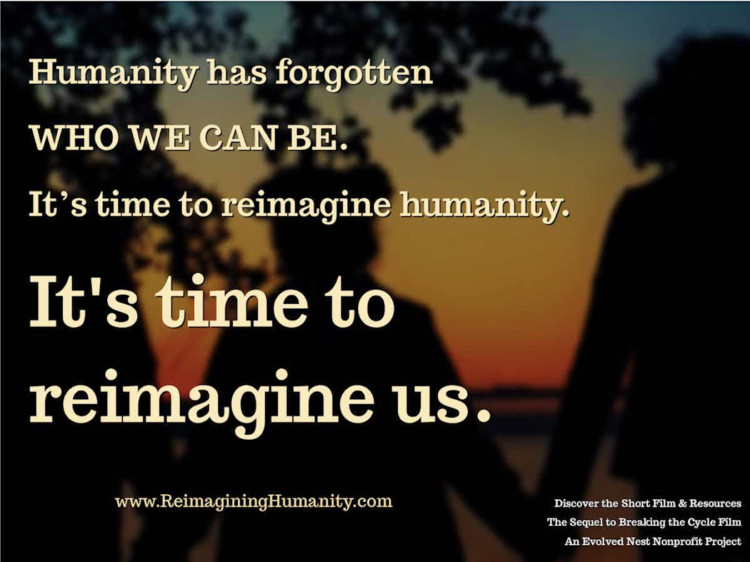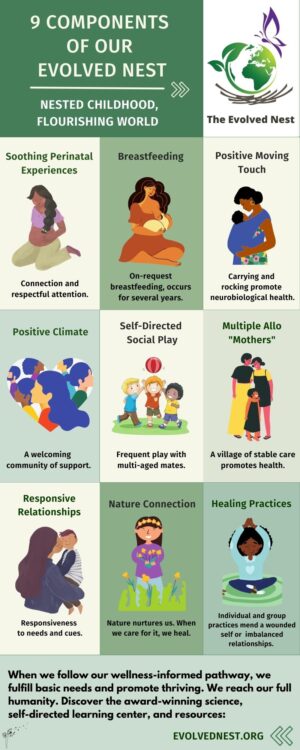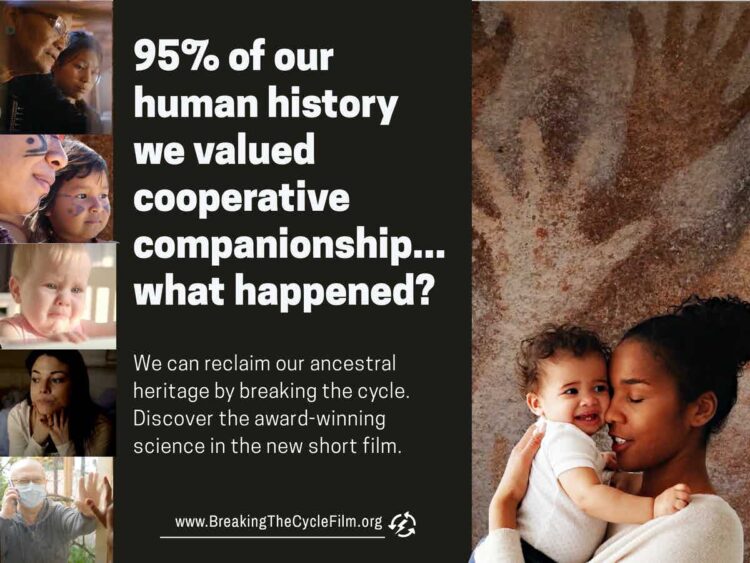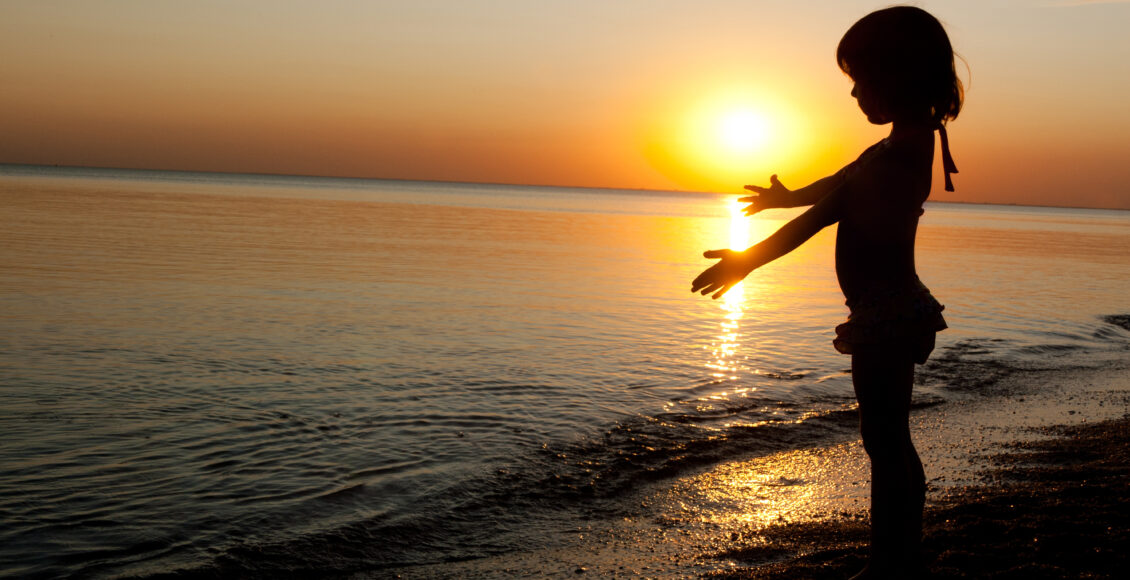Growing Children and Adults: What Does Species-Typicality Look Like?
We are immersed in species-atypical spaces growing species-atypical human beings. Our baselines for what we think is normal have shifted so much we do not realize how atypical we are. Atypical environments leave us dysregulated, easily upset, and disruptive. Species-typical childhoods nurture a healthy neurobiology, sociality, and compassionate morality. Species-typicality is needed for species and planetary wellbeing.

People like to point to the inevitable hopelessness of human nature, as if humanity is naturally selfish and aggressive. They like to point out that laws, law enforcement, and punishment are necessary for peaceful coexistence. And they tell us, look at how much more peaceful we are than our ancestors were (1). However, this is not the case. Rather, anthropological and archeological studies are showing us our largely peaceful past, in nomadic foraging bands. There were certainly violent acts, usually from male jealousy, but not from war or institutionalized discriminations or vast inequality (2).
It’s only some recent cultures, particularly Western ones, which have brought about and even condoned selfishness, aggression and the destruction of nature (3). But this does not represent our longstanding heritage. Over 95% of human existence has been spent in nomadic bands of foragers, and their contemporaries who are studied in the modern era are fiercely egalitarian, largely peaceful and cooperative, even happy (4,5). This is not the story we have been told. How can civilized notions be so different?
One of the key factors for the differences between us as civilized human beings and our hunter-gatherer cousins is the treatment of babies and children. Today, we treat them in a species-atypical manner, thereby fostering species-atypical adults. (6)
Species-Typical Child Development
In a nutshell, here is what you need to know about species-typical child development. We are social mammals descended from a line of mammals that emerged 20-40 million years ago with intensive parenting. For social mammals, social experience in early life shapes the developing functions of the brain, as countless animal experiments show. All the more so for human beings (7, 8).
Let’s consider the facts. Human babies are born with only 25% of their brain developed, resembling fetuses of most other animals until 18 months post-birth (9, 10). If babies waited any longer to be born, their heads would be too large to move through the birthing canal. Babies did not evolve to be so immature at birth without also having the scaffolding needed to optimize their rapid development post-birth. After babies are born, the way they are held and nurtured shapes their neurobiological structures, setting the trajectories for the emotional arc of their feelings, the type of intelligences they develop, their capacities for friendship and intimacy, and their orientation to the world (11, 21).
Evolution provided a developmental system, for human young that matches up with the child’s maturational schedule—what my lab calls the evolved nest. The evolved nest includes multiple overlapping features. First, the child experiences a soothing gestation, meaning that the mother is not too stressed and welcomes the child growing in her womb. Birth is soothing and natural, with no drugs or induced pain, and mother and baby are kept together, facilitating bonding and breastfeeding. The child is provided several years of breastfeeding on request, which in ancestral contexts may come from other women; breast milk is tailored to the sex and health needs of the baby at the time of suckling. The child grows up in mutually responsive relationships with mother and others. The baby is kept calm, in an optimal state of arousal, during rapid brain development, keeping the biochemical processes oriented toward growth. The child receives nearly constant touch in the first year and extensive holding and carrying in the years after. Responsive care is provided by mothers and other adults 24/7. The child spends childhood in self-directed free play with playmates of different ages. This occurs in the natural world, building ecological attunement and attachment (7, 11, 12).
Neuroscientific studies are showing the importance of each of these evolved nest components for physiological and mental health, happiness, intelligence, sociality, and compassionate morality. Allan Schore has been reviewing and summarizing the effect of mother’s nurturant care on brain development for decades. An increasing body of neurobiological evidence shows the importance of early nested care. For example, well-nurtured children develop self-regulation at multiple levels (e.g., stress response, behavioral control) whereas uncared for babies and young children can develop dysregulation in one or more systems depending on intensity, duration, and the time when distress occurred. Young children who experience more of the nest routinely are more likely to thrive and get along with others (6, 13-16).
Species-Typical Adulthood
 To understand how far from species-typicality we are, it is important to establish appropriate baselines. Under species-typical early-life nestedness and social support throughout life, human beings thrive. What does that look like? Adults who grow up and live in nest-providing communities exhibit the following characteristics:
To understand how far from species-typicality we are, it is important to establish appropriate baselines. Under species-typical early-life nestedness and social support throughout life, human beings thrive. What does that look like? Adults who grow up and live in nest-providing communities exhibit the following characteristics:
Individuals demonstrate quiet, attentiveness toward others and the environment. They have an undistracted, emotionally-present mind. They show physical vitality and a joyful glee to be alive. They respect others and the environment, recognizing the dignity of others. They display self confidence in following their own impulses, which are well-educated from experience in a community of support. They show outstanding memory, senses, and the ability to learn. They are honest with feelings and expect truthfulness from others. They express a sense of humor about the foibles and unexpected events in life. They have deep knowledge for getting along well in the particular landscape. They have an awareness of reality beyond the material, the manifest.
At the same time, the thriving individual-in-relationship is characterized by secure attachment to other people, easily communicating and cooperating in activities. They deeply enjoy being together in mutual enjoyment through joking, storytelling, dancing and other social bonding experiences. They are empathic towards others and forgiving, listening unconditionally, without judgment. They are independent but demonstrate a commitment not only to the local group but also to the whole of nature, feeling at home in the natural world. Generous sharing is practiced and expected. The uniqueness of each individual is honored, with an equal say in group decisions. No one is coerced. The sense of community and responsibility is expansive, including ancestors, future generations and the local biocommunity (6, 17, 18).
Without nest provision, these characteristics are underdeveloped because of a fundamental dysregulation of one or more systems (e.g., stress response, vagus nerve, oxytocin system) which undermines wellbeing, sense of security and ability to get along with others. Overall, species-atypicality means less intelligence, perceptiveness, and health than those raised with the evolved nest components. In modern societies, babies and children at almost every stage of development, are thwarted in their need for the nest components. As a result, we have less ability to get along with others and live cooperatively with the natural world.
But aren’t children resilient?

But, you say, kids are resilient, and the human brain is plastic. To a certain degree this is true, although this plasticity decreases with age. However, babies are different because so many systems are establishing their parameters in early life. That is, babies move through sensitive periods of development, and if the “expected” nested support is not provided, they are left in a state of distress and the scheduled growth does not occur in a healthy manner (19).
The most famous set of experiments demonstrating sensitive periods for a mammalian brain was from Michael Meaney and colleagues. They examined the effects of high-nurturing versus low-nurturing mothering in the first ten days of a rat’s life (the equivalent of about six months for a human baby). They noted that hundreds of genes were affected by maternal care during that period of time. But they initially focused on a glucocorticoid receptor protein in the hippocampus that is related to anxiety. With a high-nurturing maternal experience (any mother), the gene was expressed properly, and controlled anxiety for the rest of the rat’s life. With a low-nurturing mother, this gene was never expressed properly and the rat developed lifelong anxiety without the provision of drugs. These kinds of studies cannot be performed on humans because they require brain dissection. But because certain brain regions in rat and human are similar in structure, these findings are translatable; furthermore, brains of suicide victims who were abused as children show similar genetic effects (20, 21, 22).
But, you say, doesn’t modern child raising prepare the child for their culture? Isn’t it good to be threat reactive since there are so many threats in today’s world? It is one thing to prepare a child or adolescent for getting along in the world with self-defensive training. But when a baby is undercared for, this enhances their stress reactivity, and undermines their free will. This is because when the stress response is triggered, the blood flow shifts to mobilize muscles for action by taking blood flow away from brain areas required for higher order thinking. Lack of appropriate care for children in early life could render them controllable by fear later, which could be promoted by authoritarian figures and ideas. This is not preparation for life, but rather more like sabotage (23, 24, 25).
Implications
Civilization as we know it is damaging the development of its children in multiple ways. We’re harming their biological, emotional and social development while blunting their capacity to care for the natural world. Not surprisingly, when children grow up, their damaged nature becomes rooted in distrust, fear and self-protection, and this gets passed on from generation to generation. You can tell when a person has been well nurtured – they are kind and compassionate to others, whether familiar or not (26, 27).
We have arrived at the four horsemen of the environmental apocalypse: massive toxification, atmospheric damage, species disruption (mass extinction plus invasive species proliferating, destroying balanced ecosystems) and global burning (bringing about climate instability). Species-typical capacities include receptive intelligence for getting along with the biocommunity and natural systems of the earth. These capacities prevent us from destroying our habitat, as civilized humans are doing today. It’s obvious to indigenous peoples that species atypical humans are running the world, creating social structures that promote species-atypicality. We have been colonized by the dominant culture of industrialism, colonialism, capitalism and neoliberalism, which has become a brain- and planet-damaging machine (28, 29).
Remedies
There are two key remedies for our situation. First, everyone needs some understanding of babies and how they need the evolved nest. It is important to understand how immature babies are and how they need comforting care to grow well. People need to understand that ‘spoiling a baby’ is a myth and that the opposite is in fact true – under-caring for a baby leads to dependency, not independence. They need to know that babies cannot possibly manipulate anyone until perhaps age 3 or 4, and that even then this will only be when their needs are not being met. Babies are just communicating pain from not having one or more needs met – first with wiggling or grimaces, then gestures and finally crying. It’s always best to move in to provide comfort with the early signals. Parents today need to develop their practical understanding of baby care. They can do this by hanging around baby whisperers, those who know how to nurture babies, such as parents, grandparents, and others. They can also watch films of what responsive nurturing looks like, and they will certainly benefit from mentored practice caring for babies before having a baby. For example, one key need that many parents seem unaware of is the baby’s need to be carried, and not just pushed in a stroller or driven in a car seat, although those are better than being still. Babies need the rocking back and forth of a moving caregiver, facilitating digestion, breathing, and growth (6).
Second, let’s attend to the stories we tell and hear. The modern, Western story is one of separation and superiority to the rest of the natural world, emphasizing its dangers rather than relational respect, condoning domination and extermination. Modern stories seed distrust not only towards nature but towards other people, putting one in a threat-detection orientation which undermines prosocial cooperation. In contrast, stories in hunter-gatherer societies are about connection with one another and partnership with the natural world, including humanity’s dependence on its wellbeing. (30,31) These stories emphasize relational awareness and responsible behavior for the good of all. (5, 6, 17, 32)
Conclusion
To return to species-typicality, we need to rethink how children are nurtured and cherished. We need widespread education about the needs of young children and how to nurture them well and the policies needed to make this possible. We should tell stories of connection and dependence, of our integration and reliance on the wellbeing of a living Earth. With a shift in baselines for what is normal, we can restore a partnership society, one of cooperative companionship, where the basic needs of all are met.
This post first appeared in Culturico in April 2021.

References
- Pinker, S., “The Better Angels of Our Nature”, 2011.
- Fry, D., “War, Peace and Human Nature”, 2013.
- Turner, F., “Beyond Geography: The Western Spirit Against the Wilderness”, 1994.
- Eisler, R. and Fry, D.P., “Nurturing our Humanity”, 2019.
- Fry, D. P., “The Human Potential for Peace: An Anthropological Challenge to Assumptions About War and Violence”, 2006.
- Narvaez, D., “Neurobiology and the Development of Human Morality: Evolution, Culture and Wisdom”, 2014.
- Hewlett, B.S. and Lamb, M.E., “Hunter-Gatherer Childhoods: Evolutionary, Developmental and Cultural Perspectives”, 2005.
- Panksepp, J., “Affective Neuroscience: The Foundations of Human and Animal Emotions”, 1998.
- Trevathan, W.R., “Human Birth: An Evolutionary Perspective, 2nd ed.”, 2011.
- Montagu, A., “Brains, genes, culture, immaturity, and gestation”, In A. Montagu (Ed.), Culture: Man’s Adaptive Dimension, 1968.
- Narvaez, D., et al., “Evolution, Early Experience and Human Development: From Research to Practice and Policy”, 2013.
- Hrdy, S., “Mothers and Others: The Evolutionary Origins of Mutual Understanding”, 2009.
- Schore, A.N., “Affect Dysregulation & Disorders of the Self”, 2003.
- Schore, A.N., “All our sons: The developmental neurobiology and neuroendocrinology of boys at risk”, Infant Mental Health Journal, 2017.
- Schore, A.N., “The Development of the Unconscious Mind”, 2019.
- McEwen, B. S., “Understanding the potency of stressful early life experiences on brain and body function”, Metabolism, 2008.
- Four Arrows, and Narvaez, D. “Indigenous Eloquence and Kincentric Flourishing: Selected Quotes and Worldview Reflections to Rebalance the World”, in press.
- Young, J. et al., “Coyote’s Guide to Connecting with Nature”, 2010.
- Knudsen, E.I., “Sensitive periods in the development of the brain and behavior”, Journal of Cognitive Neuroscience, 2004.
- Bredy, T.W., et al., “Maternal care influences neuronal survival in the hippocampus of the rat. European Journal of Neuroscience, 2003.
- Caldji, C. et al., “Maternal care during infancy regulates the development of neural systems mediating the expression of fearfulness in the rat”, Proceedings of the National Academy of Sciences USA, 1998.
- McGowan, P.O., et al., “Epigenetic regulation of the glucocorticoid receptor in human brain associates with childhood abuse”, Nature Neuroscience, 2009.
- Lupien, S.J., et al., “Effects of stress throughout the lifespan on the brain, behaviour and cognition”, Nature Reviews Neuroscience, 2009.
- Miller, A., “For Your Own Good: Hidden Cruelty in Child-Rearing and the Roots of Violence, 1983.
- Arnsten, A.F.T., “Stress signaling pathways that impair prefrontal cortex structure and function”, Nature Reviews Neuroscience, 2009.
- Champagne, F. and Meaney, M.J., “Like mother, like daughter: evidence for non-genomic transmission of parental behavior and stress responsivity”, Progress in Brain Research, 2001.
- Tweedy, R., “The Divided Therapist: Hemispheric Differences and Contemporary Psychotherapy”, 2021.
- Wilson, E.O., “Biodiversity, prosperity, and value”. In F. H. Bormann & S.R. Kellert (Eds.), Ecology, Economics, Ethics: The Broken Circle, 1991.
- Narvaez, D., et al., “Indigenous Sustainable Wisdom: First Nation Know-how for Global Flourishing”, 2019.
- Narvaez, D., “Getting Back on Track to Being Human”, Interdisciplinary Journal of Partnership Studies, 2017.
- Tarsha, M., “The Evolved Nest: A Partnership System that Fosters Child and Societal Wellbeing”, Interdisciplinary Journal of Partnership Studies, 2019.
- Korten, D., “Change the Story, Change the Future”, 2015.


